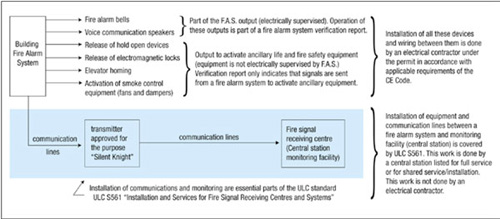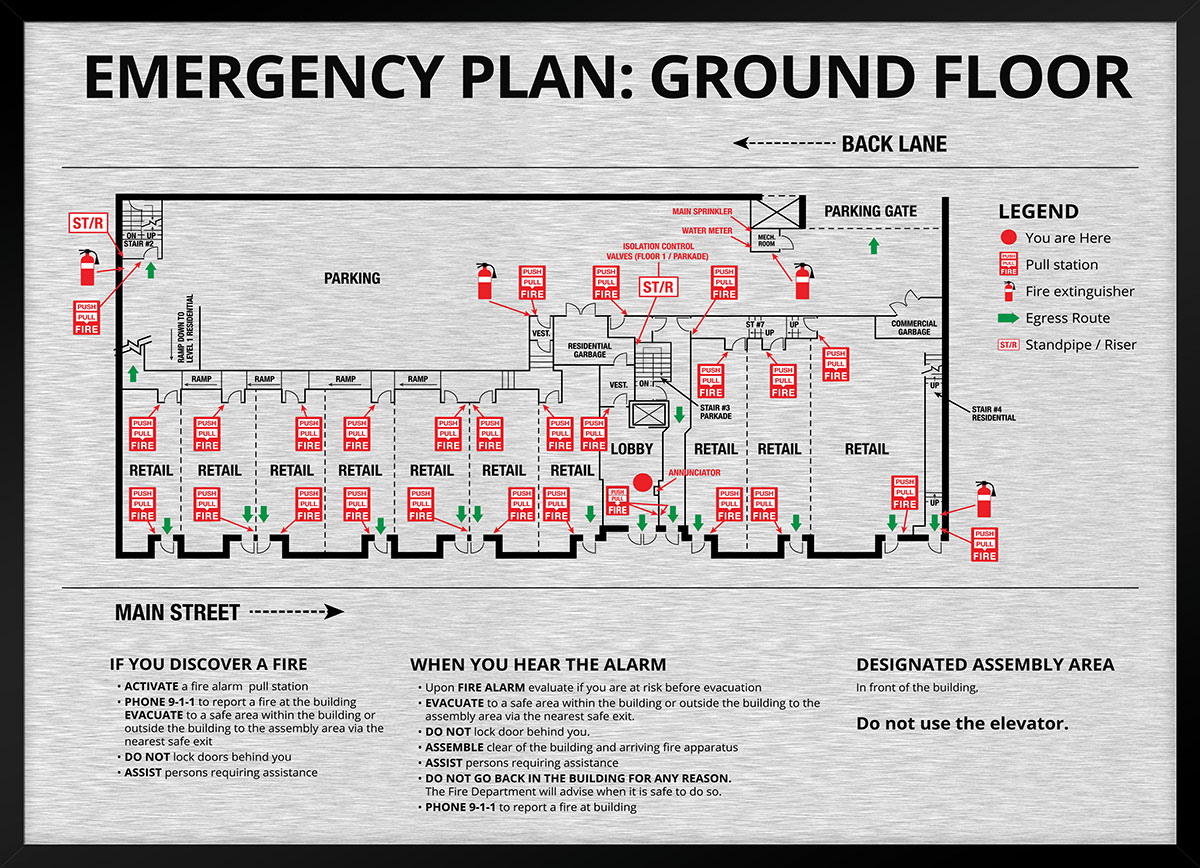Electrical installations related to fire alarm systems appear to be no different from other types of electrical work. A typical fire alarm system is an interconnected combination of:
1. the alarm initiating devices (i.e., field devices that constitute system inputs);
2. various audible signal devices such as bells, horns and speakers (i.e., field devices that constitute system outputs), and
3. central processing units such as a control unit, an annunciator, graphic display, a voice communication panel, etc. (i.e., equipment that represents system interface between inputs and outputs).
Wiring between these fire system components must be done in accordance with Section 32 of the Canadian Electrical Code, Part I. Installation of these components must comply with ULC Standard S524 “Installation of fire alarm systems” — ULC S524. This standard must be well understood by an electrical installer as the standard governs installation requirements (locations, height, spacing, etc.) for each field device and for each control unit/annunciator that is included in a typical fire alarm system.
An installer (and a designer) of the fire alarm system must also have a full understanding of the National Building Code of Canada (NBCC) requirements with respect to fire alarm systems, as the NBCC regulates the extent of the required fire alarm system components depending on the type of building occupancy and building classification. For example, if a fire alarm system is required in a hospital, then every sleeping room must be equipped with a smoke detector, and smoke detectors must be also installed in every hospital corridor that serves as a means of egress from these sleeping rooms. If, however, a fire alarm system is installed in a typical school, church, or restaurant, the NBCC does not require that smoke detectors be located in the corridors of such buildings. Therefore, if the designers or installers are not familiar with the NBCC requirements, they may needlessly spend time and money on installation of smoke detectors where such detectors are not mandated, or may omit them where their installation is necessary.

Figure 1
Another example of specific NBCC requirements regarding fire alarm systems is the additional requirement for a voice communication feature, which must be provided as a part of a fire alarm system. This feature is only mandated by the NBCC in high buildings under specific conditions, and the NBCC describes criteria for a two-way voice communication system when it has to be part of a fire alarm system. The NBCC also states that high buildings must be provided additionally with a piece of equipment called central alarm and control facility (CACF). The CACF must always be located on the storey containing the entrance for firefighter access, and it must include the following means:
(a) a means to control voice communication;
(b) a means to indicate fire alarm signals audibly and visually;
(c) a means to activate auxiliary equipment appropriate to the measure for fire safety provided in the building;
(d) a means to transmit fire alarm signals to the fire department; and
(e) a means to transmit abnormal supervisory conditions on an automatic sprinkler system to a fire signal receiving centre (a central station).
A CACF must be equipped with numerous other features, and Article 3.2.6.7 of the NBCC should be checked for all relevant requirements.
It is interesting to note that not all features required by the NBCC to be provided at a CACF actually belong to a fire alarm system. Some of these features are outside of a fire alarm system proper (i.e., they do not constitute any part of the fire alarm system input, interface or output components), and wiring methods to various pieces of this “ancillary” equipment are not regulated by provisions of Section 32 of the CEC. As this “ancillary” life and fire safety equipment does not directly belong to a fire alarm system, wiring to this equipment is not required to be electrically supervised by ULC S524 (it should be noted that Clause 3.3.1.1 of ULC S5245 requires electrical supervision of the wiring to the fire alarm system devices and lists the devices that must be electrically supervised). It is also interesting to note that operational testing of ancillary equipment is not required to be conducted during a verification of a
fire alarm system, and such verification is limited only to the devices that constitute a fire alarm system proper (devices that are electrically supervised).
Now is the time to find out what does, in fact, a verification of a fire alarm system mean. Verification of a fire alarm system is a procedure mandated by the NBCC to test operation and performance of all fire alarm system components upon completion of the fire alarm system installation.
Article 3.2.4.5. of the NBCC states that upon completion of installation, a fire alarm system must be verified in accordance with ULC standard S 537 “Verification of Fire Alarm Systems”. ULC S537 requires that such verification must be conducted by a third party (not the installing contractor) acceptable to the AHJ, to ensure that the fire alarm system is installed in conformance with ULC S524 and in accordance with the CEC, Part I, and that the fire alarm system operates satisfactorily.
And what about this mysterious ancillary life and fire safety equipment? ULC S524 defines an ancillary as a “device which has a life safety application, and is actuated by the fire alarm system, but is not part of the fire alarm system”. As it was mentioned earlier, the ULC S537 requires that a verification report only confirms that appropriate signals have been sent from the fire alarm system to actuate such ancillary equipment, but the standard does not mandate that the operation of this equipment must be tested as well. This latter requirement is governed by a coordinated life safety test in a building prior to the building’s occupancy, and it will be discussed in a separate article.
So, what is this “life and fire safety equipment” that is activated by a fire alarm system, and yet is not part of it?
Okay, let’s raise the curtain of mystery. There are different types of electrical equipment which must be activated by a fire alarm system. One of them is an electromagnetic lock installed on the exit door. When a fire alarm system is actuated, a signal must be sent to release each electromagnetic lock, unless a special relaxation is allowed by the NBCC. Another example is a hold-open device installed on a door in a required fire separation. A signal from a fire alarm system must release all holdopen devices on the doors and allow these doors to close. Where a measure for fire safety in a high building is achieved by use of a stair shaft or elevator shaft pressurization, a signal must be sent from a fire alarm system to activate all relevant motorized dampers and to start pressurization fans. Another example of fire safety equipment that could be controlled by a fire alarm system is the automatic recall (homing) of all elevators to a recall level. This homing feature also provides for an alternate floor recall option if the fire alarm initiating device has been activated on the elevator recall floor.
It may appear that the particular NBCC requirement —to transmit an alert/alarm signal to a fire department, or to transmit a trouble signal to a central monitoring station (to indicate an abnormal supervisory condition on an automatic sprinkler system) has been forgotten in our discussion. The fact is, that it has not. This is a very unique fire alarm system output, and it will be discussed a bit later.
First of all, let’s confirm the following:
1. All wiring between components of a fire alarm system must be done in accordance with Section 32 of the CE Code, and all fire alarm system components must be installed in conformance with ULC S524.
2. The installed fire alarm system must be verified by a third party acceptable to the AHJ (by other than a designer of the fire alarm system or its installer), and a verification must be done in accordance with ULC S537.
3. All wiring between a fire alarm system and ancillary life and fire safety equipment must be done in conformance with applicable rules of the CE Code.
4. All electrical work indicated in items 1 and 3 above must be done by a licensed electrical contractor under electrical permit.
Now, we can deal with signals to the fire department or to a central station. The NBCC requires that actuation of a first stage (alert) signal in a two-stage fire alarm system, or actuation of a water flow indicating device (a flow switch of a sprinkler system) must trigger transmission of a signal to the fire department. It should be noted that NBCC also requires transmission of such a signal to the fire department under other conditions (see Article 3.2.4.7.).
In addition, the NBCC mandates that electrical supervision of an automatic sprinkler system must be monitored by the central station, to allow a building management/building maintenance staff timely correction of any problems on the sprinkler system.
So, if electrical work as indicated in item 4 above must be done by an electrical contractor, who is responsible for the wiring between an acceptable central monitoring station (or fire department) and a fire alarm system installed in the building? Does this wiring have to be done under permit by an electrical contractor? Is this electrical work subject to inspection?
The answer may be found in figure 1.
As can be seen in figure 1, the entire business of transmitting signals to a central monitoring station is dealt with by the applicable provisions of ULC S561.
The scope of this standard covers the installation of a transmitter between a building’s fire alarm system and a central station, wiring between the fire alarm system and the transmitter installed adjacent to the control unit in the building, and installation (or use of the existing) acceptable communication lines between the transmitter and the monitoring station.
So, what happens if a communication line between a fire alarm system and a monitoring station is interrupted?
How will the building management staff know that the building fire alarm system is not actually connected to the monitoring station because of a potential open or short circuit on communication line?
The answer is found in ULC S561. Clause 10.1.7 of this standard mandates that “The integrity of the communication system and its communication channels shall be continuously monitored”. Therefore, if a central station is listed for conformance with ULC S561, all applicable requirements of this standard would have to be met by the central station.
ULC lists such central stations or fire signal receiving centres for:
1. full service to provide installation and monitoring
2. for shared service/installations, or
3. shared service/monitoring.
Thus, electrical work related to the installation of a transmitter and to connection of a fire alarm system to the monitoring station must be done by the organization that is listed by the ULC as a fire signal receiving centre—full service, or shared service/installation”.
Acceptance criteria of each central station’s fire signal receiving centre must be discussed with the applicable AHJ.
The city of Vancouver has published bulletins to clarify verification requirements for fire alarm systems, acceptance criteria for verification organizations and acceptance criteria for central stations. These Bulletins: 2000-019-EL; 2000-021-EL; and 2003-009-EL are available on the city of Vancouver websitehttp://vancouver.ca. Refer to the Community Services Department under Licenses and Inspections/Related Information.














Find Us on Socials